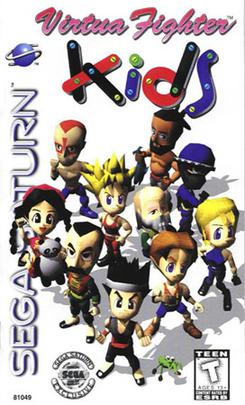Virtua Fighter Kids
| Virtua Fighter Kids | |
|---|---|
 North American Saturn cover art | |
| Developer(s) | Sega AM2 |
| Publisher(s) | Sega |
| Director(s) | Makoto Osaki |
| Producer(s) | Yu Suzuki |
| Programmer(s) | Takayuki Yamaguchi |
| Composer(s) | Kazuhiko Kouchi |
| Series | Virtua Fighter |
| Platform(s) | Arcade, Saturn |
| Release | Arcade 1996 Saturn |
| Genre(s) | Versus Fighting |
| Mode(s) | Single player, multiplayer |
| Arcade system | ST-V |
Virtua Fighter Kids[a] is an installment in the Sega AM2 Virtua Fighter fighting game series. A super deformed version of Virtua Fighter 2,[1] it was released in the arcade and on the Sega Saturn in 1996. Unlike Virtua Fighter 2, it was developed on the ST-V board.[2]
All the characters have big heads, and the music is at a faster pace. The gameplay itself is slightly tweaked from Virtua Fighter 2. The Saturn version includes some new FMVs and programmable button sequences to allow players to test and use pre-made combos.[3] Despite being children, some of the fighters retain the adult characteristics of their Virtua Fighter 2 counterparts, such as facial hair, muscles, and breasts.[4][5]
One of the variations of the boss character, Dural, features her with a fishbowl for a head, complete with a fish swimming inside.[6]
Release[]
Merchandise for the game in Japan included a line of stuffed toys which sold very well even before development on the game was finished.[7]
In Japan, Virtua Fighter Kids was released on the Saturn as a promotional item in co-operation with drink brands "Java Tea" and "Energen" under the title "Virtua Fighter Kids: Java Tea Original Edition". It was later released commercially without any mention of "Java Tea" on the cover. All Java Tea product placement was removed from the western versions of the game,[8] but is present in all Japanese versions (arcade,[9] regular and Java Edition).
Appearances in other games[]
Although no official sequels to Virtua Fighter Kids were ever made (other than the VF Kids versions of the CG Portrait Series in Japan called the Game Gear Portrait Series), the child versions of Akira Yuki and Sarah Bryant reappear as playable characters in Fighters Megamix,[10] and some of their fellow playable characters appear in the game's ending movie as well. The Kid styles of Akira Yuki and Sarah Bryant were made into figures in the Sega Dreamcast game Shenmue.
Reception[]
| Aggregator | Score |
|---|---|
| GameRankings | 73% (6 reviews)[14] |
| Publication | Score |
|---|---|
| EGM | 6.25/10 (SAT)[4] |
| GameSpot | 6.6/10 (SAT)[11] |
| Next Generation | |
| Sega Saturn Magazine (UK) | 91% (SAT)[12] |
| MAN!AC | 88/100 (SAT)[13] |
In Japan, Game Machine listed Virtua Fighter Kids on their May 1, 1996 issue as being the third most-successful arcade game of the year.[15]
Virtua Fighter Kids divided reviewers to an extent. GameSpot, Scary Larry of GamePro, and Dan Hsu, Crispin Boyer, and Sushi-X of Electronic Gaming Monthly said that while Virtua Fighter Kids would have made an amusing bonus mode in Virtua Fighter 2, it was not worthwhile as a full-price standalone release.[4][11][16] On the other side, Next Generation, Rich Leadbetter of Sega Saturn Magazine, and Shawn Smith of Electronic Gaming Monthly argued that features such as the funny cinemas, the new facial expressions on the characters, and the new kid-themed scenery make the game more than a money-making gimmick, though they also said that it is not as good as the original version of Virtua Fighter 2.[4][5][12] Most reviewers criticized the short reach of the kid characters.[4][5][11][16]
Notes[]
References[]
- ^ "Virtua Fighter Kids Set For an Arcade Release!". Sega Saturn Magazine. No. 5. Emap International Limited. March 1996. p. 7.
- ^ "Virtua Fighter Kids Makes Progress". Sega Saturn Magazine. No. 6. Emap International Limited. April 1996. p. 17.
- ^ Guise, Tom (August 1996). "Kindergarten Kung-Fu!". Sega Saturn Magazine. No. 10. Emap International Limited. pp. 48–53.
- ^ Jump up to: a b c d e "Review Crew: VF Kids". Electronic Gaming Monthly. No. 88. Ziff Davis. November 1996. p. 76.
- ^ Jump up to: a b c d "The Kids Are All Right". Next Generation. No. 23. Imagine Media. November 1996. p. 272.
- ^ "Tips: Virtua Fighter Kids". Sega Saturn Magazine. No. 13. Emap International Limited. November 1996. p. 77.
- ^ "The Fighting Game Action from Sega Hits Fever Pitch!". Maximum: The Video Game Magazine. No. 5. Emap International Limited. April 1996. p. 118.
- ^ Leadbetter, Rich (September 1996). "A Word from Our Sponsors". Sega Saturn Magazine. No. 11. Emap International Limited. p. 63.
- ^ "Model 3: Sega Affirms Arcade Supremacy". Next Generation. No. 17. Imagine Media. May 1996. pp. 12–18.
- ^ "Fighters Megamix - Saturn". Game Informer. Archived from the original on October 21, 1997.
- ^ Jump up to: a b c "Virtua Fighter Kids Review". GameSpot. December 1, 1996. Archived from the original on November 7, 2017. Retrieved November 5, 2017.
- ^ Jump up to: a b Leadbetter, Rich (September 1996). "Review: Virtua Fighter Kids". Sega Saturn Magazine (UK). No. 11. Emap International Limited. pp. 62–63.
- ^ Andreas Knauf (2018-10-18). "Virtua Fighter Kids - im Klassik-Test (SAT)". MANIAC.de (in German). Retrieved 2019-05-11.
- ^ "Virtua Fighter Kids for Saturn". GameRankings. Archived from the original on 2015-09-09.
- ^ "Game Machine's Best Hit Games 25 - TVゲーム機ーソフトウェア (Video Game Software)". Game Machine (in Japanese). No. 517. Amusement Press, Inc. 1 May 1996. p. 25.
- ^ Jump up to: a b "ProReview: VF Kids". GamePro. No. 99. IDG. December 1996. p. 146.
External links[]
- 1996 video games
- Arcade video games
- Video games developed in Japan
- Sega-AM2 games
- Sega arcade games
- Sega Saturn games
- Virtua Fighter